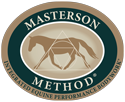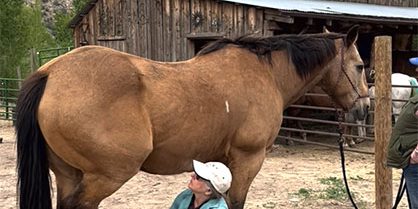by Megan Dushin
As a student of The Masterson Method, you will likely learn in your first Masterson book, video, and/or course about symmetry and asymmetry in the horse, and how we consider the horse’s “predominant diagonal” in order to start the side that is likely to be easiest.
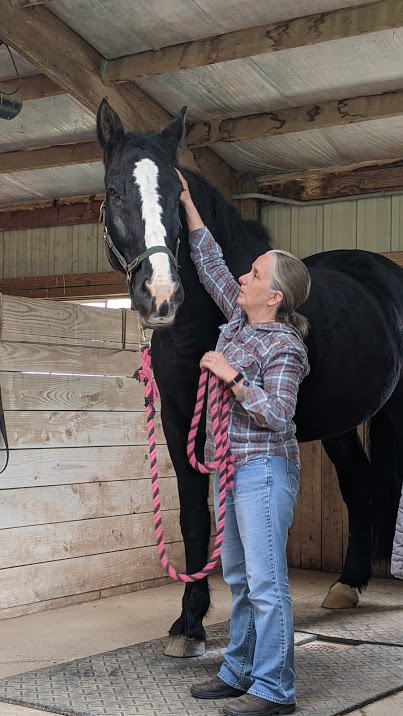
Megan starting with Bladder Meridian Technique on the left front of a very tall horse!
The predominant diagonal is the equivalent of having a dominant hand for horses. Horses carry their weight predominantly on a diagonal pair of legs (right front and left hind, or left front and right hind), and that’s a beautiful thing. If they carried their weight on the same side (right front and right hind) they would be less stable and could topple over if startled. Since horses are prey animals, they need to be able to escape a predator in a millisecond; it’s instinctual and essential for survival.
During my fieldwork phase of learning The Masterson Method (after taking the Advanced 5-Day Course), I realized how confused I was about this predominant diagonal and what it meant for restriction patterns in the horse’s body. In our case studies, we are asked to assess both reactions and restrictions in the horse’s body and compare left to right, as well as how much improvement was gained with repeat attempts of range-of-motion techniques. I still hadn’t wrapped my head around what the predominant diagonal meant in terms of reactions or restrictions in the body.
I realized why I was confused. As a gymnast in my youth, I believed that my more flexible side was also my stronger, dominant side. I was a “lefty” which meant I started my cartwheels with my left leg forward and had more flexibility in splits with my left leg forward. But what that meant was that my right leg was stronger and doing the work of launching my body across the beam, floor, or “horse” (vault), and my left leg was more flexible and could lead more easily. It’s all the same body mechanics; I just had the phrasing backwards.
It was Beckie Haynes, my Block 2 Mentor, who first opened my eyes to what it means to be “predominant” (I’m sure Jim mentioned this in my Advanced 5-Day but I probably wasn’t ready to hear it at the time). It finally hit me when she said the predominant diagonal pair for horses is the diagonal set of legs that do the most work, that bear the most weight. It’s then the opposite diagonal pair of legs that do the most leading (e.g., the leg that might start the walk from a stand still more often or the side that is the preferred canter lead). Sometimes it takes several times before I can really hear it. Now I could understand why the predominant diagonal pair of legs are more restricted; they do the most work!
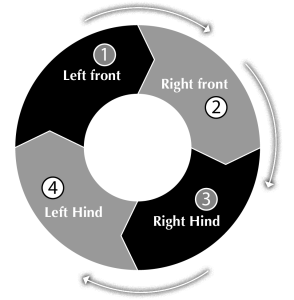 In most horses, the predominant diagonal is the right-front/left-hind (the cause for this is a whole other topic that I won’t go into here), abbreviated as RF/LH. This means horses tend to be more restricted in the right front and left hind. Since in The Masterson Method we start where it’s easiest (one of the many mottos from Jim), we start techniques on the left front when working with the front end, and right hind when working with the hind end, especially when doing range-of-motion or movement techniques.
In most horses, the predominant diagonal is the right-front/left-hind (the cause for this is a whole other topic that I won’t go into here), abbreviated as RF/LH. This means horses tend to be more restricted in the right front and left hind. Since in The Masterson Method we start where it’s easiest (one of the many mottos from Jim), we start techniques on the left front when working with the front end, and right hind when working with the hind end, especially when doing range-of-motion or movement techniques.
It’s not so important with the light-touch techniques like Bladder Meridian where we go down one whole side of the horse at a time using air-gap pressure and use “Search for a Response, Stay for a Release” or SRSR because we’re not asking for movement in the joints. But when doing leg releases or techniques where we’re asking for movement in a relaxed state, we’ll generally start on the easy side which tends to be the left front and right hind. The sequence would be this: left front, right front, right hind, left hind. Unless… we know or discover during the session that the horse is one of those rare gems who is LF/RH predominant; then we work the other direction: right front, left front, left hind, right hind.
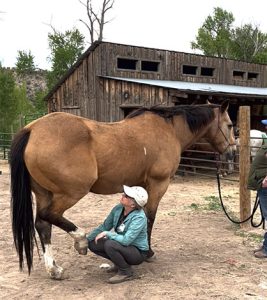
Megan doing the Farrier Position on a horse’s right hind leg (generally the easier side on the hind end)
As you go further into your education and especially if you complete the practitioner certification program, you learn that there are common reaction and restriction patterns in the typical RF/LH horse to look for (these same patterns will show up for the atypical LF/RH horse, but in the opposite way). If the horse has those common patterns, but then you discover an anomaly in your findings, that’s something you learn to get curious about and start asking questions. And the search begins. Not all horses have anomalies or things going on that are out-of-the-ordinary, but knowing the patterns can help guide the bodywork. This is one of the reasons Masterson Method Certified Practitioners can be so effective at uncovering patterns and improving performance.
Having a predominant diagonal is not a bad thing. It’s natural, and in fact, it’s impossible to NOT have a predominant diagonal. We’re not trying to work that out of the horse in any way. We’re just using that knowledge to help balance the horse and identify where there may be issues causing discomfort in the body.
There’s a whole lot of great information about symmetry and asymmetry in horses, and how we approach this in The Masterson Method:
- If you want to hear Jim’s wisdom on the topic (I highly recommend reading this), see What Your Horse Might Have to Say About One-sidedness.
- If you’d like help with your horse from a local practitioner, see Find a Certified Equine Practitioner.
- Lastly, if you’re hungry to learn more, I highly recommend you look up a course near you.
I hope this was useful, and perhaps you can watch which leg your horse walks off with first the next time he comes to say hello to you or another friend! If there’s a consistent leg that leads, it may be that this is his flexible front leg (opposite hind leg would be his flexible hind leg). If you’re practicing Masterson Method techniques with your horse, start where it’s easy – on those flexible sides.
This article was written by Megan Dushin, MMCP and MMES. Megan first learned about The Masterson Method through a Facebook algorithm back in 2015. She says, “Thank you technology!” She was hooked the moment she saw Jim’s way of being around and listening to horses. Megan offers bodywork services in Minnesota and teaches Masterson Method courses around the USA. For more about the author, go to Megan Dushin, MMCP, MMES.
